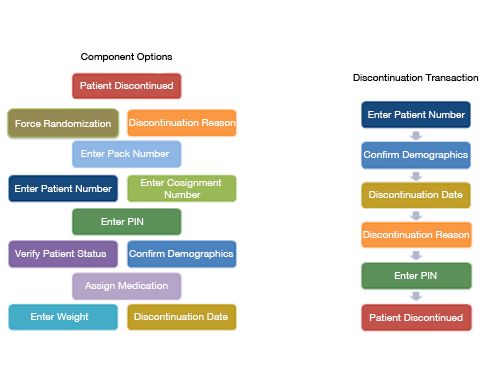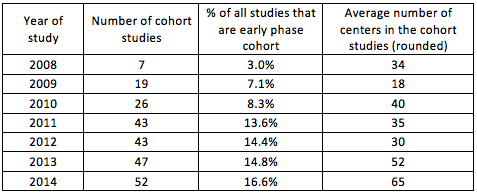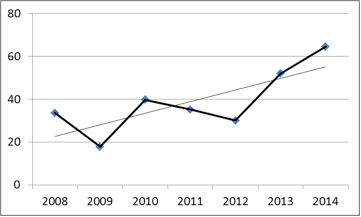Applying New Technology to Randomization, Cohort Management and Dosing in Multi-center Early Phase Trials
Applied Clinical Trials
The drive to accelerate drug development has highlighted the benefit in using RTSM systems within early phase cohort trials.
Introduction
Phase I and early Phase II studies generally have the aim of establishing the safety, tolerability and pharmacokinetics of one or more doses and formulations. Designs used include the 3+3 design, up and down designs and the continual reassessment method.1 In some studies the dose progression is fixed in advance and the dose planned for each cohort is known. In other studies, however, the dose step used for subsequent cohorts may be determined by the number of toxicities observed in the previous cohort, for example, and future doses are not known in advance.
Randomization and Trial Supply Management (RTSM) services use Interactive Response Technology (IRT), via telephone and the web, to manage randomization, study medication dispensing and inventories in many clinical studies.2 In addition to managing randomization and trial supplies, they are also useful to monitor real time recruitment, manage emergency treatment code-breaking and perform calculations to ensure accuracy of dosing.3 However there have, historically, been a number of barriers to the adoption of RTSM services in early phase trials. The unique challenges of these safety focused studies include:
1) Many of these studies have tended to be conducted at a single center so that the randomization, dose dispensing, blood sampling procedures and progression between successive cohorts could be tightly managed manually. This negated the need for an RTSM system.
2) Studies often need very rapid design changes as more is learned about a new drug.
3) Early phase studies have relatively small study budgets for technology.
The drive to accelerate drug development has highlighted the benefit in using RTSM systems within early phase cohort trials. One benefit is the potential for these studies to be opened up to more centers, often located in different countries. Traditionally, RTSM systems allow management of the numbers recruited to each cohort which is difficult, if not impossible, to coordinate manually with many centers.
Typical RTSM Functionality
When determining how to manage an early phase cohort study, it the required flexibility is often too complex to be implemented in a cost-effective RTSM system. However, recent developments in RTSM system design have made it possible to produce validated configurable components which allow an RTSM system to handle the most commonly requested functionality, even in the area of cohort management. A typical modern RTSM system will have standard options available for: opening and closing of cohorts, randomization of patients, dispensing of medication to patients, recruitment caps, patient replacement (including randomization) and other patient interactions. Figure 1 shows how smaller ‘pre-validated’ RTSM components can be combined to create more complex RTSM transactions.
Figure 1: Example RTSM component options and an example transaction that could be constructed from the components.

Utilizing a configurable approach like that described in Figure 1 can achieve shorter study delivery timelines. Modern, configurable RTSM systems can typically enable delivery of study technology within four to eight weeks, and in as little as two weeks with some study requirements. Study Sponsors benefit through simpler and less burdensome specification and UAT (User Acceptance Testing) processes. In addition, Sponsors require less expertise in system deployment. This approach also reduces cycle times in implementation of study changes, which is a particular requirement in early phase trials where knowledge is still being accumulated about a new drug.
The benefit of recruitment capping
As previously noted, the potential for early phase cohort studies to be opened up to more centers allows the acceleration of the drug development process for the Sponsor. Early phase studies may typically require recruitment of a small number of patients and, if these are to be recruited across many centers, then a mechanism to avoid over-recruitment is required. An RTSM system can behave as the 'gate-keeper' in studies with stop-start recruitment. Recruitment into a fixed cohort of patients can therefore be controlled centrally across multiple locations.
Intelligent replacement of study patients
In studies with a small number of patients, withdrawals can materially affect any subsequent data analysis. If a patient withdraws before reaching the desired stage of their progression, then it may be required to ensure functionality to replace the patient in order to achieve sufficient evaluable patients balanced in treatment assignment within a cohort. The most common requirement is that lost patients are replaced on a “like for like” basis, i.e. the replacement patient receives the same treatment as the withdrawn patient. The replacement process then effectively forces a “replacement patient” onto the treatment arm of the withdrawn patient.
In randomized double-blind studies managed without automated methods, successful replacement may be achieved by having a set of duplicate medication packs with the same numbering system as the original set held in reserve. However, this is wasteful of medication which is often expensive and in short supply. By automating this process with an RTSM system, there is no need for duplicate medication and the replacement can be accomplished in a completely blinded manner, thereby reducing the risk of partially un-blinding a patient.
In order to accommodate replacement randomizations, we should consider the randomization list design. This is particularly acute where each cohort may require a separate randomization list – a common occurrence in these types of studies. Replacement is facilitated within the randomization list through the use of spare randomization records which are specifically reserved for “replacement patients.” These records are only used when a replacement randomization is required after a withdrawal occurs, not to randomize “normal” patients (Fig. (2)). By using a replacement list entry, a “like for like” treatment group replacement is guaranteed. Once the replacement entry has been used, then a return to the main randomization list is made for the next “normal” randomization.
If the randomization number is a key patient identifier that needs to be communicated to centers, then the randomization number should be scrambled to mask the replacement process.
Figure 2: An example RTSM randomization schedule that is set up with replacement randomization functionality. Note that only four “normal” randomization entries are shown with a possible replacement for each. In reality not all randomization entries would require replacement and the “normal” randomization list section would be significantly longer than the replacement list sections.

The decision of whether or not to enforce a replacement for a withdrawn patient can be made automatically by the system, based on agreed parameters, or activated manually by a study team member.
Prevalence of early phase cohort studies within the general population of clinical trials using RTSM systems
An examination of the database of PAREXEL Informatics containing approximately 2,600 studies put live since January 1, 2008 was conducted to determine the incidence and types of studies being conducted and the functionality employed by them. An automated scan for the phrase ‘Cohort’ revealed a total of 237 cohort studies.
Table 2 shows the number of cohort studies per year put live and the proportion of all RTSM studies put live in the same period which this figure represents. The average number of centers per study is also shown. There appears to be a steady increase in the proportion of RTSM studies that are early phase cohort studies since 2008 which would indicate an increasing trend towards the use of RTSM systems for studies of this type.
Table 2: Early phase cohort studies per year since 2008 supported by PAREXEL Informatics RTSM systems.

The increase in incidence of early phase cohort studies was accompanied by a trend towards an increasing average number of centers per study of this type. This is shown in Figure 3 and would support the hypothesis that studies of this type are becoming larger in terms of number of centers.
Figure 3: The average number of centers per cohort study using PAREXEL Informatics RTSM systems since 2008. The linear trend line is also shown.

Conclusions
A survey of the incidence of early phase cohort studies performed using PAREXEL Informatics RTSM systems showed that, since 2008, the incidence of early phase cohort studies utilizing RTSM systems has increased both in overall numbers, and as a percentage of all RTSM studies put live by PAREXEL. This upward trend was accompanied by an overall increase in the average number of study centers per study of this type. This reflects the trend for early phase studies to use RTSM services, particularly multi-center proof of concept studies. These studies have therefore been enabled through the development of flexible, configurable RTSM systems that can efficiently meet the specific, required demands.
Malcolm Morrissey PhD, Richard Roberts B.Sc, Barry O’Gorman, Darren Wells CGMA, PAREXEL Informatics
References
[1] Chevret S. Statistical Methods for Dose-Finding Experiments. New York, NY: John Wiley & Sons 2006.
[2] Waters S, Enhancing Control of the Medication Supply Chain in Clinical Trials Managed by Interactive Voice Response Systems. Drug Information Journal. 2010; 44: 649-662.
[3] Byrom B. Using IVRS in clinical trial management. Applied Clinical Trials. 2002; 10: 36-42.
How Digital Technology and Remote Assessment Strategies Can Aid Clinical Trial Research
July 24th 2020While there's been hopeful news on treatments and vaccines, sponsors should plan to discuss necessary strategies and contingencies at the outset of new studies or re-opening of halted studies during the COVID-19 pandemic.